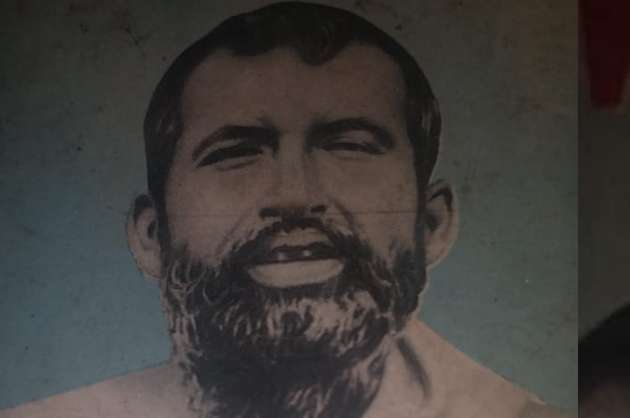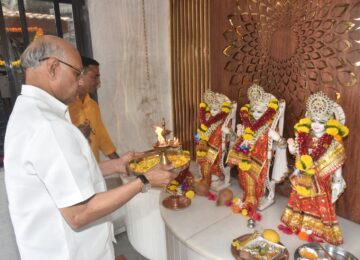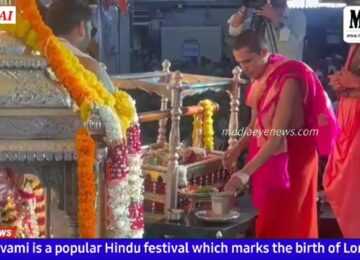Anupama Nair
www.mediaeyenews.com
The story of Ramakrishna Paramahamsa is a story of religion in practice. His life embraces us to see God face to face. We cannot read the story of his life without being convinced that God alone is real and the rest is illusion. He was the living embodiment of Godliness, and his sayings are not those of a learned man, but they are the pages from the book of his life. They are revelations of his own experiences. In today’s world of skepticism, he is a living example of bright and living faith, which gives solace to us, in this troubled times if we bother to read his books. Ramakrishna’s life was a lesson in Ahimsa or non-violence. His love encompassed all and knew no limits.
He is the Guru of Swami Vivekanand. He is responsible for converting Narendra Dutta to Swami Vivekananda. Swamiji is one of the persons who has inspired me in every aspect of my life. Just reading his book “My India, Eternal India” on a train journey changed my views of my great Bharat Maa. In the words of a disciple of Swamiji Sister Christine “Our love for India came to birth, I think, when we first heard him (Swami Vivekananda) say the word, "India", in that marvelous voice of his. It seems incredible that so much could have been put into one small word of five letters. It seems incredible that so much could have been put into one small word of five letters. There was love, passion, pride, longing, adoration, tragedy, chivalry, and again love. Whole volumes could not have produced such a feeling in others. It had the magic power of creating love in those who heard it.” The result was me–, a big fan of the Western life and philosophy began to look towards my own country of birth.
I came to know about Sri Ramakrishna as my family for years were associated with the Ramakrishna Mission and a visit to the Mission was frequent in childhood. When I grew up, I worked as a teacher for the Rama Krishna Mission, Jamshedpur. That was the first time I saw a school, where children who could not afford to pay the school fees were not penalized. The education provided to the children was of highest quality. From Jamshedpur, I had the good fortune to visit Dakshineshwar and the Belur Mutt.
He was born as born Gadadhar Chattopadhyaya in February 1836 in the village of Kamarpukur in the Hoogly district of the Indian state of Bengal, into a very poor, pious, and orthodox Brahmin family. Kamarpukur was undamaged by the glamour of a city and contained paddy fields, tall palms trees, royal banyans, a few lakes etc., unlike Calcutta. His parents were Khudiram Chattopadhyay and Chandramani Devi. It is believed that Sri Ramakrishna's parents experienced supernatural incidents and visions before his birth. In Gaya, his father Khudiram had a dream in which Lord Vishnu or Gadadhara appeared and said that he would be born as his son. Chandramani Devi had a vision of light entering her womb from a Shiva temple. The family was devoted to Hindu Lord Rama, and all their male children were given names –Ramkumar, Rameshwar, and Ramakrishna.
He rejected the traditional method of schooling, but was well versed in Ramayana, Mahabharata, Puranas etc. He however, was a talented boy, and could sing and paint well. He was fond of serving holy men and listening to their discourses. He was often found to be absorbed in spirituality. At the age of six, he experienced the “first ecstasy” while watching a flight of white cranes moving against the background of black clouds near a paddy field. This tendency to enter into ecstasy intensified with age. His father’s death when he was only seven years old, served to deepen his introspection and increase his detachment from the samsara or the world.
When Sri Ramakrishna was sixteen, his elder brother Ramkumar took him to Calcutta to assist him in his priestly duties. In 1855, the Kali Temple at Dakshineswar was built by Rani Rasmani (a rich zamindarin) , was sanctified and Ramkumar became the chief priest there. When he died a few months later, Ramakrishna was appointed as the priest. Ramakrishna developed intense devotion to Mother Kali and spent hours in loving adoration, forgetting the rituals of the temple and his priestly duties. His intense longing concluded into the vision of Mother Kali as boundless effulgence engulfing everything around him.
To the world who has seen many intoxication – alcohol, power, money, god-intoxicated state was new. This state alarmed his relatives in Kamarpukur and they got him married to Sarada, a girl from the neighboring village of Jayrambati. After his marriage, Sri Ramakrishna plunged into even more intense spiritual practices and impelled by a strong inner urge to experience the different aspects of God he was helped by a series of Gurus who taught him the various paths described in the Hindu scriptures, and he realized God through each one of them. His first guru in 1861 was a remarkable woman known as Bhairavi Brahmani who was well versed in scriptures. With her help Sri Ramakrishna practiced various difficult disciplines of the Tantrik path, and attained success in all of them. Three years later came a wandering monk by name Totapuri, under whose guidance Sri Ramakrishna attained Nirvikalpa Samadhi, the highest spiritual experience mentioned in the Hindu scriptures. He remained in that state of non-dual existence for six months without the least awareness of even his own body. In this way, Sri Ramakrishna relived the entire range of spiritual experiences of more than three thousand years of Hindu religion within a few years. Remarkable isn’t it!
With his voracious thirst for God, Sri Ramakrishna broke the frontiers of Hinduism, he glided through the paths of Islam and Christianity, and attained the highest realization through each one of them in a short span of time. He looked upon Jesus and Buddha as incarnations of God, and venerated the ten Sikh Gurus. He expressed the quintessence of his twelve-year-long spiritual realizations in a simple belief “Yato mat, tato path (As many faiths, so many paths)”. He now habitually lived in an exalted state of consciousness in which he saw God in all beings.
In 1872, Sarada, who was now nineteen years old, came from the village to meet him. He received her cordially, and taught her how to attend the household duties and at the same time lead a spiritual life. It is said, one night he worshipped her as the Divine Mother in his room at the Dakshineswar temple. Although, Sarada continued to stay with him, they lived pure lives, and their marital relationship was only spiritual. They never lived like a married couple. It should be mentioned here that Sri Ramakrishna had been ordained a Sannyasi, and he observed the basic vows of a monk to perfection. But outwardly he lived like any lay man — humble, loving and with childlike simplicity. During Sri Ramakrishna’s stay at Dakshineswar, Rani Rasmani acted as his patron and after her death, her son-in-law Mathur Nath Biswas took care of his needs.
I will talk more about him in the next part. At the outset, it was Sri Ramakrishna, Sarada Devi and Swamiji who inspired me to write this article. I am only an instrument and it was Mother Kali who came as thoughts in my mind, which got converted into words.
(to be continued)





























Anupama took me on a spiritual journey. Proud of my religion
Jai Gurudev. Inspirational story for my children. Liked her story on Vivekanda too. Thank you media eye for awakening us
Proud to know you Anu for years. Proud of you. Great article. Nice website.
Must publish more articles
Love it.
Jai Gurudev.
Jai gurudev
Jai Gurudev
Jai Gurudev
Good job done by Anupama and Media Eye
Good job done by Anupama and Media Eye
Good job done by Anupama and Media Eye
Great guru
Great guru
Jai Guru dev
Jai Gurudev and Ma
Jai Gurudev and Ma
Jai Gurudev and Ma
Loved it
Jai gurudev.
jai guru dev
Jai Gurudev
Jai Gurudev
Jai Gurudev
There is a Rama Krishna Mission here.
Great gurus of India.
Great gurus of India.
Great article.
Jai Gurudev. Anupama really your Guru has inspired you to write this.
Jai gurudev
Jai gurudev.
Jai gurudev
Jai gurudev
Jai Gurudev.
great guru of India
great guru of India
great guru of India
great guru of India.
great guru of India.
great guru of India.
Jai Gurudev
Jai Gurudev
Jai Gurudev
Jai Gurudev
Jai Gurudev
Nice article.
Nice article.
Great Guru.
Great Guru.
Great article.
Great article.
Ramakrishna and Vivekananda pride of India
Ramakrishna and Vivekananda pride of India
Ramakrishna and Vivekananda pride of India
Jai gurudev.
Jai gurudev.
Jai gurudev
Jai gurudev.
Great guru
Great guru